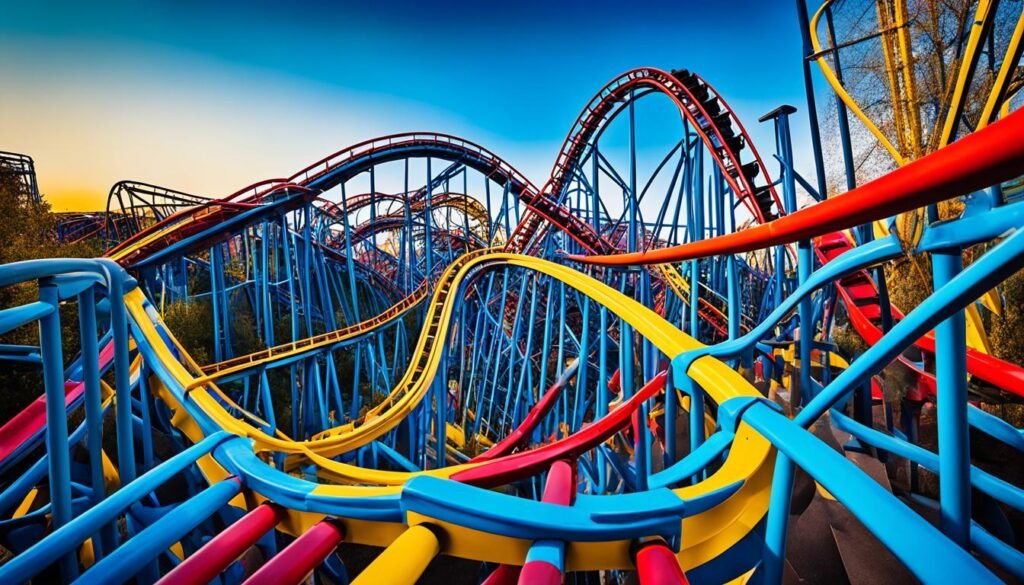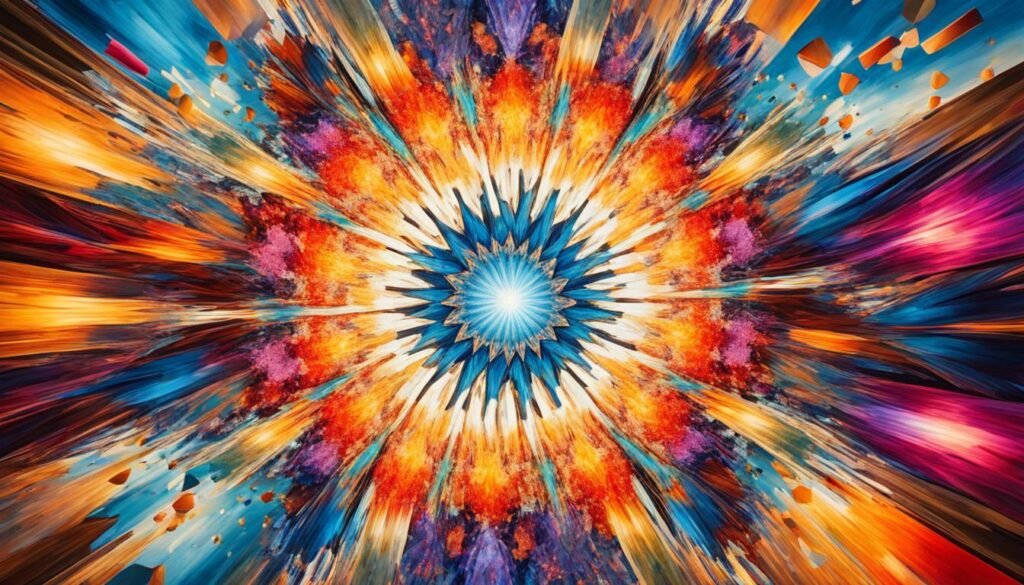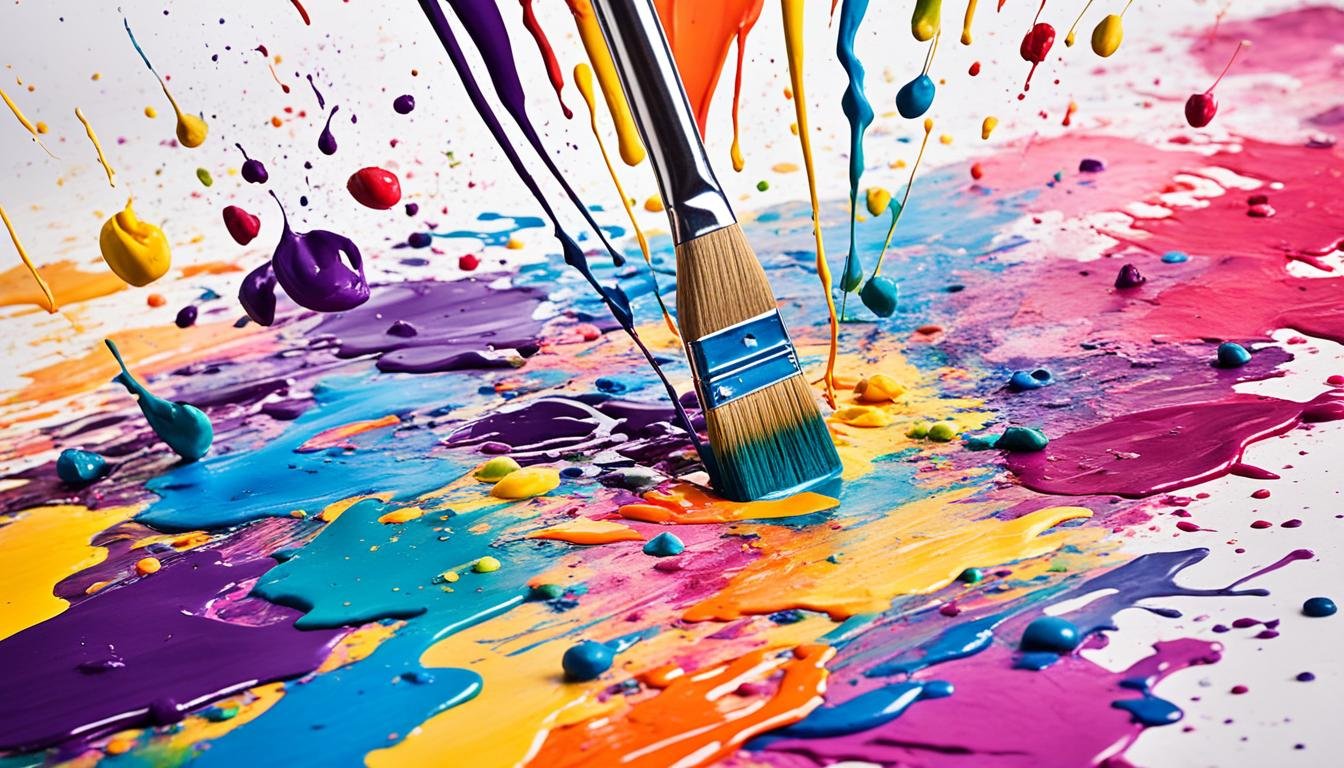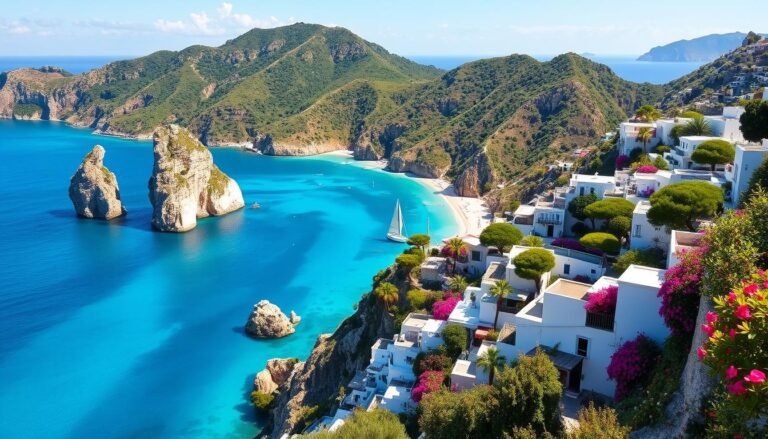Imagine stepping into a realm where the boundaries between reality and imagination blur, where colors dance across the canvas, and each brushstroke tells a captivating story. Welcome to the captivating world of art, a realm where creativity knows no bounds. Join me as we embark on a journey to uncover the secrets of artistic inspiration and unlock the boundless potential that lies within.
What ignites the spark of creativity in the hearts of artists? Is it a chance encounter with a breathtaking landscape, a deep dive into the realm of personal experiences, or the profound connections forged among fellow creatives? Prepare to explore the intricate tapestry of art inspiration and discover the multifaceted ways in which artists find the muse to bring their visions to life.
Key Takeaways
- Discover the power of art inspiration, from nature and personal experiences to interacting with fellow artists
- Explore the digital age of art and uncover the countless resources available to art enthusiasts
- Unlock your inner artist and immerse yourself in the transformative world of visual expression
- Gain insights into the captivating world of art, igniting your creativity and passion for visual arts
- Delve into the various styles, techniques, and artists that make the art world so diverse and fascinating
What is Art Inspiration?
Art inspiration is the captivating energy that infuses new ideas, colors, textures, and designs into an artist’s mind and body of work. It’s the magical spark that ignites creative projects, transforming the ordinary into the extraordinary. Whether it’s the beauty of nature, the allure of architecture, the resonance of music, or the masterful works of other artists, inspiration can come from a multitude of sources.
Unveiling the Essence of Artistic Motivation
In our exploration of artistic motivation, we’ll uncover the secrets to overcoming artist’s block and cultivating the creative spark that fuels your artistic expression. From the mystical visions of Romantic poets to the psychological insights of Sigmund Freud, the nature of inspiration has long captivated the human imagination.
Inspiration, as described in the Book of Amos, can be a profoundly overwhelming experience, compelling the artist to speak. John Locke’s 18th-century model of the human mind linked ideas association to inspiration, while the Romantic poets saw it as a divine or mystical encounter. Sigmund Freud and later psychologists located inspiration within the artist’s inner psyche, and the Marxist theory of art viewed it as an expression of economic positions.
Yet, for contemporary artists, inspiration can arise from the most ordinary of sources. Consistent studio work, journaling, reading, and even observing daily life can all contribute to the creative spark that ignites new artistic visions. By embracing the diverse wellsprings of inspiration, artists can navigate the challenges of artist’s block and continue to evolve their craft.
“Inspiration is mentioned in the Book of Amos 3:8 in the context of being overwhelmed by God’s voice and compelled to speak.”
As we delve deeper into the essence of artistic motivation, we’ll discover the transformative power of art inspiration and how it can elevate the creative process, empowering artists to express their unique visions with passion and authenticity.
Nature: An Eternal Muse
From the vibrant blooms of spring to the brilliant hues of autumn, nature serves as an endless source of artistic inspiration. Renowned painters like Claude Monet, Winslow Homer, John James Audubon, and Henri Rousseau have long drawn from the beauty and diversity of the natural world, capturing its essence on canvas.
Monet, the mastermind behind the iconic The Artist’s Garden at Giverny, carefully curated his garden to suit his artistic vision, favoring annual flowers like poppies, sunflowers, and nasturtiums. Similarly, Vincent van Gogh, while in emotional turmoil, found solace in painting the lush, early-summer flowers and grass that surrounded him.
Surrealist artist Joan Miro’s captivating masterpiece, The Farm, was inspired by his family’s countryside estate, showcasing the beauty and simplicity of rural life. This deep connection with nature extends to contemporary artists as well, with young talents like Santhosh Kotagiri and Vasantha Raja using natural landscapes as their muse.
“I had no teacher other than nature.”
– Henri Rousseau, renowned French painter
Kotagiri’s nature-inspired works feature a unique color palette dominated by shades of red and ochre, infusing a sense of mysticism and introspection. His paintings and installations explore the subconscious imagery of the natural world, blending the past, present, and future in captivating ways.
Meanwhile, Vasantha Raja’s installations capture the transient feelings experienced when observing nature, with intricate lines and textures playing a central role in his artistic expression. The upcoming Looking Inwards Beyond exhibition at Forum Gallery in Chennai promises to be a celebration of nature’s enduring influence on the artistic community.
Whether it’s the vibrant hues of a wildflower meadow or the serene calm of a secluded forest, the natural world continues to be an eternal muse, inspiring generations of artists to translate their awe and wonder into breathtaking works of art.
Life Experiences: A Canvas of Emotions
Our life experiences can be a rich source of art inspiration. A travel journal or photo album can become a wonderful starting point as we recreate sunsets, sunrises, mountain peaks, and urban architecture in our work. Even a challenging experience can be turned into artistic expression, serving as a canvas for our emotions and personal narratives.
Transforming Personal Narratives into Artistic Expression
Art has the power to help us process and express our life experiences, emotions, and personal stories. By channeling our unique perspectives and feelings onto a canvas, we can create meaningful works that resonate with others. The freedom of expression through painting or drawing allows us to explore the depth of our inner selves, transforming our life experiences into captivating artistic creations.
Engaging with art often requires slowing down and being fully present in the moment. This mindful approach can lead to personal growth, self-discovery, and a deeper understanding of the human condition. Art enhances our appreciation of the world around us and provides a refreshing break from daily routines, allowing us to set aside our worries and distractions.
Whether it’s a vibrant landscape or an abstract expression of a challenging life event, our personal narratives can become a source of inspiration for our artistic endeavors. By embracing our individuality and allowing our imagination to run wild, we can unlock the true power of art to convey our emotions, experiences, and unique perspectives.

“Every art piece carries a unique message that can resonate deeply with viewers’ emotions and experiences.”
So, let’s embark on a journey of self-expression, where our life experiences become the canvas for our emotions and personal narratives. Discover the transformative power of art and unleash the artist within, one brushstroke at a time.
Interacting with Fellow Artists
As an artist, connecting with fellow creatives can be a game-changer in sparking new inspiration and overcoming creative roadblocks. Networking within the artist community offers a wealth of opportunities to share techniques, discuss strategies for tackling artist’s block, and find mutual support.
Attending local workshops or joining an artist community can be a fantastic way to engage with other artists. Here, you can exchange ideas, gain valuable feedback, and even discover new techniques that you can incorporate into your own artistic practice. The shared experience of navigating the ups and downs of the creative journey can be incredibly fulfilling and rejuvenating.
While Edgar Degas was not a dancer himself, his fascination with the world of ballet inspired some of his most iconic sculptures. This cross-pollination of artistic disciplines showcases the power of stepping outside your comfort zone and drawing inspiration from unexpected sources.
| Networking Challenges for Artists | Networking Opportunities for Artists |
|---|---|
|
|
Embracing the artist community and engaging with your peers can be a transformative experience. By sharing your challenges, receiving support, and learning from one another, you can unlock new avenues of artistic expression and overcome creative roadblocks with renewed vigor.
“Networking can be challenging and time-consuming for artists, but it’s worth the effort. Approach it with a positive attitude and focus on forming genuine connections – you never know where they might lead.”
Exploring New Artistic Realms
As an artist, stepping outside your comfort zone and exploring new mediums can be a transformative experience. Traditional art markets may be facing challenges, but the digital world has opened up a wealth of opportunities for artists to showcase their work and connect with a global audience.
The rise of platforms like Etsy, Saatchi Art, and Society6 has empowered artists to reach art enthusiasts worldwide, showcasing their creations in a digital gallery. Furthermore, cross-industry collaborations with brands, businesses, and designers have led to commissions and exposure in unconventional spaces, such as cafes, hotels, and offices.
Social media platforms, like Instagram and Facebook, have also become a vital tool for artists to build digital galleries, engage with followers, and connect with influential individuals. Persistence and adaptability are crucial in this ever-evolving landscape, as artists must stay attuned to changing trends and consumer preferences while maintaining their artistic vision.
Jean-Michel Basquiat’s art is a prime example of the power of exploring new artistic realms. His unique blend of street art, abstraction, and neo-expressionism in his paintings defy categorization, often delving into themes of race, power, and societal dichotomies. His two-dimensional work “Bird on Money” showcases a mesmerizing blend of mixed-media elements, while his sculpture “Skull” is a captivating mixed-media piece that transcends traditional art boundaries.
“Basquiat’s paintings offer a psychedelic and abstract journey of human emotion and touch, transcending traditional representation and embracing the enigmatic and inviting exploration of emotional landscapes.”
The amalgamation of visual elements and textual nuances in Basquiat’s paintings grants them a multi-dimensional quality, allowing for various interpretations and engaging the senses beyond the visual. Exploring new art mediums, from sculpture and painting to drawing and unconventional creative perspectives, can be a rewarding and inspiring journey for any artist.
Embracing the Art Masterpieces
Drawing inspiration from the art masterpieces of the past can be a profound and transformative experience. As we immerse ourselves in the captivating world of art history, we uncover a wealth of techniques, styles, and creative processes that can inform and ignite our own artistic journeys.
Take, for instance, the iconic Edward Hopper painting “Nighthawks.” It’s said that this 1942 work was inspired by the literary genius of Ernest Hemingway and the evocative night scenes of Van Gogh. By studying the masterful interplay of light and shadow, the haunting mood, and the captivating narrative in “Nighthawks,” we can glean insights that can elevate our own artistic expression.
Immerse yourself in the art masterpieces that captivate your senses. Follow renowned artists on social media, visit museums and galleries, and dive deep into the creative processes that shape their work. Let their mastery inspire you to push the boundaries of your own artistic exploration.
“The purpose of art is washing the dust of daily life off our souls.” – Pablo Picasso
By embracing the art masterpieces of the past and present, we open ourselves up to a world of possibilities. From the bold brushstrokes of Van Gogh to the minimalist elegance of Edward Hopper, each work of art offers a unique lens through which we can refine our own artistic vision and uncover new avenues of creative expression.

So, let the art masterpieces be your guide, your inspiration, and your muse. Immerse yourself in their timeless beauty, and allow their transformative power to shape your artistic journey, one captivating stroke at a time.
Joining Art Classes and Workshops
Unleashing your creative potential is easier than you might think. Art classes and workshops offer a gateway to discovering new artistic realms and honing your skills. From pottery classes in Boston to paint and sip events in Atlanta, these immersive experiences led by experienced instructors provide the perfect opportunity to learn, experiment, and connect with like-minded individuals.
Immersing in Artistic Communities
Stepping into an art class or workshop is more than just a skill-building exercise – it’s a chance to immerse yourself in a vibrant artistic community. These interactive sessions foster a supportive environment where you can exchange ideas, receive valuable feedback, and find inspiration from fellow creatives. Whether you’re a beginner or an experienced artist, joining these communities can be a transformative experience, igniting your passion and accelerating your growth.
Standalone workshops are distinguished by a one-time event setup, while art classes entail a commitment to a series of sessions. Beginner art classes are often in high demand, with ten-week programs typically reaching full capacity. Workshop lengths can vary, with some lasting as little as two hours, like a lampshade-making class. Considerations should be given to the number of participants that can be accommodated during a workshop to ensure personalized attention.
The pricing of workshops and classes factors in material costs, equipment wear and tear, venue expenses, and refreshments. Many participants find themselves expanding beyond their initial class, exploring new mediums and techniques. Collaboration with other artists and makers can be beneficial, as sharing course information can lead to a wider reach and more engaged communities.
To attract participants, it’s crucial to promote workshops through social media channels and websites. Creating waiting lists and utilizing testimonials in marketing campaigns can further enhance the visibility and success of future classes. Offering diverse types of classes, such as one-to-one or couples workshops, can cater to different preferences and needs of participants.
Whether you’re a beginner seeking to unleash your creative potential or an experienced artist looking to expand your horizons, joining art classes and workshops can be a transformative experience. Immerse yourself in vibrant artistic communities, learn from skilled instructors, and unlock your inner artist. Embark on this journey and let your creativity soar!
Art Inspiration Books
Art inspiration books can be a treasure trove for creatives seeking to ignite their artistic flames. These resources delve into the rich history, movements, and techniques that have shaped the world of art. From exploring the abstract expressionism of Wassily Kandinsky to uncovering the bold strokes of Jackson Pollock and the contemplative hues of Mark Rothko, these books provide a gateway to understanding the unique qualities of various art forms.
Whether you’re a seasoned artist or a budding enthusiast, art inspiration books can offer a wealth of guidance and motivation. Titles like “In Pursuit of Inspiration: Trust Your Instincts and Make More Art” and “Art is the Highest Form of Hope & Other Quotes by Artists” can spark creativity and encourage you to embrace your artistic aspirations.
- “The Artist’s Way: A Spiritual Path to Higher Creativity” by Julia Cameron has an average rating of 3.95 with 113,240 ratings and was published in 2002.
- “Art and Fear: Observations on the Perils (and Rewards) of Artmaking” by David Bayles has an average rating of 3.78 with 92,988 ratings and was published in 1994.
- “Ish (Creatrilogy)” by Peter H. Reynolds has an average rating of 4.39 with 11,546 ratings and was published in 2004.
- “Steal Like an Artist: 10 Things Nobody Told You About Being Creative” by Austin Kleon has an average rating of 3.96 with 298,862 ratings and was published in 2012.
- “An Illustrated Life: Drawing Inspiration from the Private Sketchbooks of Artists, Illustrators, and Designers” by Danny Gregory has an average rating of 3.72 with 25,590 ratings and was published in 2008.
- “Alphabetica: An A-Z Creativity Guide for Collage and Book Artists” by Lynne Perrella has an average rating of 4.03 with 2,028 ratings and was published in 2006.
These art inspiration books offer a diverse range of resources, from exploring the neuroscience of creativity to uncovering techniques for overcoming creative blocks. Whether you’re seeking to deepen your understanding of art history, enhance your artistic skills, or simply ignite your imagination, these captivating books can be your gateway to a world of creative inspiration.
“Creativity is allowing yourself to make mistakes. Art is knowing which ones to keep.” – Scott Adams
Virtual Galleries and Online Art Communities
The digital age has revolutionized the way art enthusiasts can engage with and discover artistic expression. Platforms like Artsy, Google Arts & Culture, and Behance offer virtual gallery experiences, allowing you to explore collections from leading museums and galleries around the world.
During the COVID-19 pandemic, virtual art galleries played a crucial role in community engagement efforts. These digital spaces showcased artworks reflecting themes of resilience, social cohesion, and creativity amidst the global crisis. For instance, 18 participants from various university affiliations submitted artworks exploring key themes of reflecting, advocating, and engaging through diverse mediums such as digital drawings, paintings, short films, and poetry.
Online art communities like DeviantArt provide a thriving hub for artists to showcase their work, connect with fellow creatives, and participate in collaborative projects. These platforms saw a remarkable growth in membership during the lockdown period, as individuals sought artistic outlets to combat feelings of isolation and foster joy, comfort, and connections with others.
The arts were leveraged to promote social cohesion and well-being during times of uncertainty, showcasing the promise for future interventions and risk mitigation plans. The pandemic also led to a significant increase in virtual art exhibitions, with a growing number of art organizations planning to continue hosting these digital experiences post-pandemic.
Dive into the digital realm of artistic expression and uncover the endless possibilities for inspiration and creative exploration through virtual galleries and online art communities.
Exploring the Digital Realm of Artistic Expression
The COVID-19 pandemic has accelerated the shift towards virtual art experiences, with a percentage increase in online exhibitions compared to in-person events. Artsy, Google Arts & Culture, and Behance have become hubs for art enthusiasts to discover and engage with diverse artistic expressions from the comfort of their homes.
Furthermore, online art communities like DeviantArt have seen a substantial growth in membership during the lockdown period, as artists and art lovers sought creative outlets to connect and collaborate. The ratio of artworks sold through virtual galleries has also increased, indicating the growing acceptance and accessibility of digital art platforms.
As the world navigates the post-pandemic landscape, the continued popularity of virtual art experiences suggests a promising future for the digital realm of artistic expression. Many art organizations are planning to maintain their virtual exhibition offerings, recognizing the value they provide in engaging broader audiences and fostering a sense of community among art enthusiasts.

“The arts were leveraged to promote social cohesion and well-being during times of uncertainty, showcasing the promise for future interventions and risk mitigation plans.”
Art Inspiration in Everyday Life
As an artist, I’ve found that the key to unlocking endless art inspiration lies in embracing the beauty and wonder of everyday life. From the captivating landscapes I encounter during my travels to the endearing antics of my beloved pets, the world around me serves as a never-ending wellspring of creative fuel.
One of my favorite sources of inspiration comes from simply observing the people around me. People watching – whether at a bustling café, a lively park, or a crowded city street – allows me to study the diverse range of human expressions, gestures, and interactions. These fleeting moments often spark ideas for new art pieces, from candid portraits to dynamic scenes capturing the drama of everyday life.
I also find immense inspiration in the stories and emotions conveyed through movies, books, and music. Immersing myself in these artistic mediums transports me to new realms, broadening my perspective and igniting my own creative impulses. The way a filmmaker captures light and shadow, the way a writer articulates the complexities of the human experience, or the way a musician evokes a specific mood – these are the kinds of elements that often find their way into my own work.
Ultimately, the key to nurturing art inspiration in everyday life is to keep an open mind and a curious spirit. By embracing the beauty, the wonder, and the profound moments that surround us, we can unlock a wellspring of creativity and transform the mundane into the extraordinary.
As the great artist Pablo Picasso once said, “The purpose of art is washing the dust of daily life off our souls.” By finding inspiration in the everyday, we can elevate our lives and our art, creating works that resonate with the human experience in all its complexity and beauty.
The Role of Museums and Art Institutions
Museums and art institutions play a vital role in preserving, showcasing, and fostering artistic expression throughout history. These cultural hubs not only display masterpieces but also serve as educational resources, providing invaluable insights into art movements, techniques, and the evolution of artistic expression. By visiting museums, attending lectures and workshops, and exploring the wealth of knowledge and experiences they offer, art enthusiasts can deepen their appreciation for the art world, connect with its rich cultural heritage, and find inspiration to fuel their own creative journeys.
From the renowned Metropolitan Museum of Art in New York City, which has commissioned new works from acclaimed artists like Jeff Koons, Cindy Sherman, and Kara Walker, to the innovative Museum of the Future in Dubai, which focuses on technological development and innovation, museums around the world are playing a pivotal role in shaping the art landscape.
The Tate Modern in London, for instance, frequently hosts exhibitions of work by emerging artists, providing a platform for their creative expression. Similarly, the Louvre Museum in Paris makes its vast collection accessible to the public through various programs and exhibitions, fostering a deeper understanding and appreciation of art history.
The role of museums and art institutions extends beyond just displaying art. They also serve as educational hubs, with the Museum of Black Civilizations in Dakar promoting the contributions of Black people to global civilization, and the National Museum of Ethiopia in Addis Ababa showcasing significant artifacts, including the famous fossil “Lucy.”
Furthermore, these institutions play a crucial role in supporting artists, both financially and through the provision of resources and platforms for their work. The Museum of Modern Art in New York City, for example, offers financial support through the MoMA Artists Council, while the Zeitz Museum of Contemporary Art Africa in Cape Town showcases the rich and diverse collection of modern and contemporary African art.
As the art world continues to evolve, museums and art institutions remain at the forefront, adapting to the changing landscape and embracing new technologies and approaches to engage with a wider audience. From the digitally-focused Museum of the Future to the traditional yet dynamic Benin City National Museum in Nigeria, these cultural hubs are shaping the future of art appreciation and education.
“Museums have the power to shape our understanding of the world, to preserve our cultural heritage, and to inspire new generations of artists and art lovers.”
Conclusion
In the digital age, I have discovered a wealth of resources to unlock the captivating world of art. From virtual galleries and online art communities to educational platforms and critical analysis, the opportunities for artistic inspiration and self-expression have never been more accessible. Whether I’m a passionate collector, an aspiring artist, or simply someone who appreciates the beauty of creative expression, this journey has provided a comprehensive guide to unleashing my inner artist and embracing the transformative power of art.
As I continue to immerse myself in the diverse tapestry of artistic mediums, styles, and movements, I am inspired to let my creativity soar to new heights. The course has filled knowledge gaps, particularly in the realm of contemporary art practices, emphasizing conceptual and installation art. I’ve recognized the importance of enhancing my academic writing skills, including structure and referencing, to align with the standards of the field.
Moving forward, I am committed to designing more effective research projects, understanding and responding to research briefs efficiently, and further developing my critical and evaluation skills. Artists like Nathan Coley, Jenny Holzer, Edward Ruscha, Richard Long, and Ian Hamilton Finlay, as well as artworks such as Katie Paterson’s Vatnajokull, Sam Taylor Wood’s decaying fruit videos, and Nathan Coley’s A Place Beyond Belief, will continue to inspire and influence my artistic journey. With the valuable resources identified, including the Khan Academy and Google Arts Project, I am poised to explore the boundless potential of art in the digital age.




